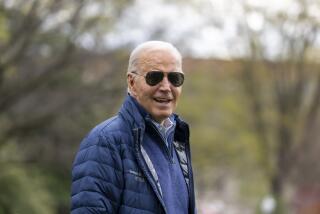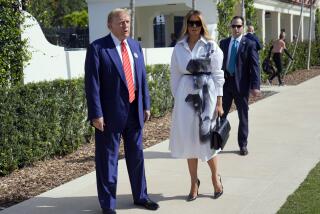President Obama hits battleground state of Ohio hard
CINCINNATI —President Obama long ago seized on Ohio as his top reelection target. He has bombarded it with a larger volume of TV advertising than any other state. And since launching his campaign — in Ohio, not coincidentally — he’s given Ohioans more opportunities to hear from him in person than voters in any other battleground.
On Wednesday, he returned to the state to frame the election as a choice between policies to benefit the wealthy and those that boost the middle class.
“Ohio, we do not need more tax cuts for the wealthiest Americans,” Obama told to a crowd of 3,000 gathered at a civic center in downtown Akron, noting that both he and his Republican opponent Mitt Romney would benefit from Romney’s tax plan. “We need tax cuts for working Americans.”
It’s a well-worn bit of trivia that no Republican has ever made it to the White House without carrying Ohio. That may help explain why the Buckeye State has been a favored campaign destination for Romney too, and the target for more of his TV ads than other states.
But no Democrat since John F. Kennedy has won the presidency without Ohio either, so the Obama campaign is heavily investing its most precious resource — the president’s time — to keep Ohio’s bellwether streak going.
The Obama visit to Akron and Mansfield represented his 25th trip to Ohio as president. Since he formally opened his re-election run in May, Obama has been to Ohio almost every other week on average, a pace matched by Romney.
“The president is the greatest megaphone we have,” said Aaron Pickrell, a senior Obama campaign advisor who directed the Ohio operation in 2008. “If we can have the best advocate for the president — the president himself — we bring more voters in.”
A new statewide opinion survey shows Obama leading Romney by six percentage points, 50 percent to 44 percent, among likely voters in Ohio. The poll, conducted for a consortium that includes Quinnipiac University, CBS News and the New York Times, was completed Tuesday and has a margin of error of three percentage points.
Like his latest Ohio swing, all but two of Obama’s campaign stops in recent months have been to the media markets of northern Ohio, which combined reach about half of the state’s voters. The heavily Democratic band of suburbs and urban centers spans the shores of Lake Erie, from Toledo to Cleveland, down through Akron and east to Youngstown. The area reflects the industrial heritage of a state that is older, whiter and growing more slowly than the rest of the nation.
A presidential visit — complete with Air Force One arrival — can capture the local news cycle for a day or longer. Obama has multiplied the impact of his Ohio campaign swings by giving interviews to TV stations from other parts of the state.
Rallies like the ones Wednesday are also valuable tools for recruiting and energizing volunteers — an important factor in an election that may turn more on mobilizing supporters than on persuading the relatively small number of undecided voters.
“It gets people fired up. It gets them ready to go out and do something,” said Obama volunteer Karen Micka, 58, a mental health therapist from Dayton who attended the president’s kickoff rally in Columbus and a Michelle Obama rally in Dayton last week.
In 2008, Obama carried Ohio by less than his national margin, and his chances of holding the state depend, in part, on his ability to turn out African Americans in urban centers like Cleveland, Toledo and Columbus, a swing area in the middle of the state. Yet Obama is also hitting places with significant numbers of white middle-class and lower-middle-class voters — key targets of both presidential campaigns — including suburbs south of Cleveland and on the outskirts of Youngstown.
Nothing better reflects the president’s determination to compete almost everywhere than his recent visit to Cincinnati. This hilly river city, praised by Longfellow as the Queen of the West, is the capital of Ohio’s Republican heartland. John A. Boehner, the GOP speaker, represents the area in the House of Representatives, as did Rob Portman, one of those being considered as Romney’s running mate, before his 2010 election to the Senate.
“If we win Ohio, Mitt Romney will be the next president of the United States,” Boehner told local GOP supporters last month, emphasizing the need to drive up turnout in the heavily Republican suburbs outside Cincinnati.
The Cincinnati area, it can be argued, was responsible for the reelection of the last Republican president. Ohio’s electoral votes decided the presidential election, and the Cincinnati area decided Ohio. In 2004,George W. Bushgained a 160,000 vote lead over John F. Kerry in five-county metropolitan Cincinnati, overcoming the Democrat’s 42,000-vote edge in the rest of the state.
Four years later, Obama became the first Democrat since 1964 to carry Hamilton County, which includes Cincinnati, thanks to strong African American turnout and support from moderate whites in close-in suburbs. But he’ll have a hard time carrying it again.
“Hamilton County is one of the toughest places for a Democrat to win. Cincinnati is one of the most Republican big cities in America,” said Democratic strategist Paul Begala, who is working for the pro-Obama “super PAC” Priorities USA Action.
Of the 45 campaign offices Obama has opened statewide, six are in the Cincinnati area.
“He has put offices in rather unlikely places in southwest Ohio, simply to minimize the extent of the Republican vote,” said Republican state Sen. Bill Seitz of Cincinnati, a Romney supporter.
A prime example: Cheviot, an overwhelmingly white, Republican suburb of 8,500 in western Hamilton County. According to Seitz, who represents it, Cheviot had a reputation into the mid-20th century as a place where African Americans had to be out of town by sundown.
When the Obama office opened two months ago, “people were initially surprised.... But what Obama realizes, to his credit, is that anything he can do to bolster his vote in southwest Ohio will help,” Seitz said. “He’s going to have to fight for every square inch of this state.”
A wild card is Romney’s choice of a running mate. If Romney picks Portman, Ohio’s junior U.S. senator, it could add a percentage point or more to the GOP ticket’s total in the state, according to politicians on both sides.
Obama is working hard to contain any loss.
He paid close attention during a July 16 visit to Cincinnati’s signature culinary product, with a lunchtime stop at Skyline Chili. The president ordered takeout: a 4-way with beans (translation: plate of spaghetti piled high with chili, shredded cheddar cheese and red beans) plus two Coneys (chili dog with mustard and shredded cheddar), handing the bag to an aide before leaving.
That afternoon, at the first town-hall-style event of his reelection campaign, he brought up his support for the federal bailout of the auto industry, which he said affected 1 in 8 jobs in Ohio. Obama has used the bailout as a major selling point against Romney, who opposed it.
“Let me just say, everybody, I am going to be back in Cincinnati,” Obama concluded, to applause from supporters. “I’m going to be back in Ohio.”
And on Wednesday, he was.
One in a series of occasional stories on the states that will determine the next president.
More to Read
Start your day right
Sign up for Essential California for news, features and recommendations from the L.A. Times and beyond in your inbox six days a week.
You may occasionally receive promotional content from the Los Angeles Times.






